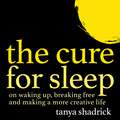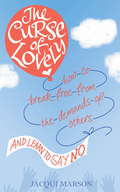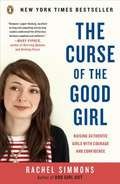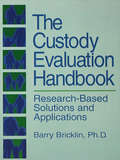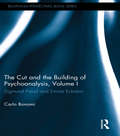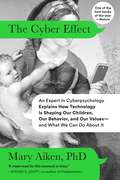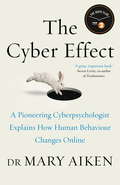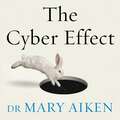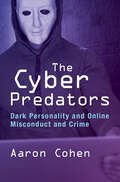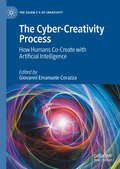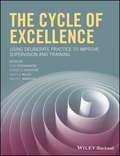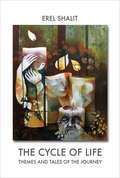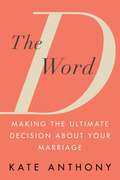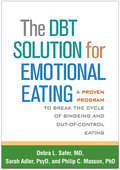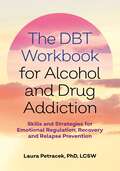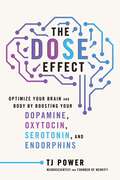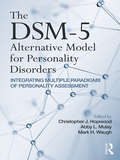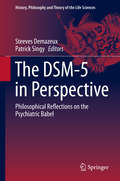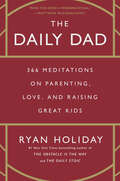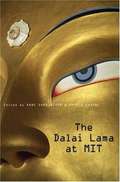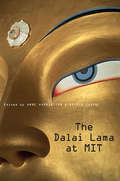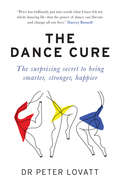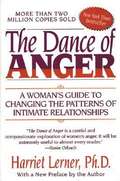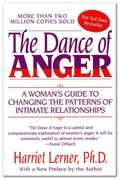- Table View
- List View
The Cure for Sleep (W&N Essentials)
by Tanya ShadrickJust days into motherhood, a woman begins dying. Fast and without warning. On return from near-death, Tanya Shadrick vows to stop sleepwalking through life. To take more risks, like the characters in the fairy tales she loved as a small girl, before loss and fear had her retreat into routine and daydreams. Around the care of young children, she starts to play with the shape and scale of her days: to stray from the path, get lost in the woods, make bargains with strangers. As she moves beyond her respectable roles as worker, wife and mother in a small town, Tanya learns what it takes - and costs - to break the spell of longing for love, approval, safety, rescue.
The Curse of Lovely: How to break free from the demands of others and learn how to say no
by Jacqui MarsonMany people's lives, relationships, careers and wellbeing are blighted by the belief that to be liked, loved and accepted they have to limit themselves to the behaviours they believe are approved of by others. This might mean some or all of the following: always being polite, nice, helpful, charming, fun, making people feel good about themselves, not letting people down, never saying 'no', avoiding conflict and putting others' needs before their own. In her 15 years of clinical experience as a psychologist Jacqui Marson has coined the phrase 'the curse of lovely' to describe this growing trend. Many people would like to be known as lovely, but for a growing number of people it can feel like a curse. They feel unable to put their own needs before those of everyone else, and feel that changing this is not an option. This highly practical and motivational book will show readers how to break curse of lovely to live a more complete, fulfilling life. Contents include: when 'lovely' turns into a curse; the lovely child - how it all begins; the different shades of lovely - which one are you?; from curse to gift - how we can still be lovable and get our needs met; but what do I want - how to tune in to what your body is telling you; re-evaluating anger; saying 'no' and surviving; how to instigate scary conversations; and how to replace the personal rules that put you at the bottom on the pile.
The Curse of the Good Girl
by Rachel SimmonsBestselling author of Odd Girl Out, Rachel Simmons exposes the myth of the Good Girl, freeing girls from its impossible standards and encouraging them to embrace their real selves In The Curse of the Good Girl, bestselling author Rachel Simmons argues that in lionizing the Good Girl we are teaching girls to embrace a version of selfhood that sharply curtails their power and potential. Unerringly nice, polite, modest, and selfless, the Good Girl is a paradigm so narrowly defined that it's unachievable. When girls inevitably fail to live up- experiencing conflicts with peers, making mistakes in the classroom or on the playing field-they are paralyzed by self-criticism, stunting the growth of vital skills and habits. Simmons traces the poisonous impact of Good Girl pressure on development and provides a strategy to reverse the tide. At once expository and prescriptive, The Curse of the Good Girl is a call to arms from a new front in female empowerment. Looking to the stories shared by the women and girls who attend her workshops, Simmons shows that Good Girl pressure from parents, teachers, coaches, media, and peers erects a psychological glass ceiling that begins to enforce its confines in girlhood and extends across the female lifespan. The curse of the Good Girl erodes girls' ability to know, express, and manage a complete range of feelings. It expects girls to be selfless, limiting the expression of their needs. It requires modesty, depriving the permission to articulate their strengths and goals. It diminishes assertive body language, quieting voices and weakening handshakes. It touches all areas of girls' lives and follows many into adulthood, limiting their personal and professional potential. Since the popularization of the Ophelia phenomenon, we have lamented the loss of self-esteem in adolescent girls, recognizing that while the doors of opportunity are open to twenty-first-century American girls, many lack the confidence to walk through them. In The Curse of the Good Girl, Simmons provides a catalog of tangible lessons in bolstering the self and silencing the curse of the Good Girl. At the core of Simmons's radical argument is her belief that the most critical freedom we can win for our daughters is the liberty not only to listen to their inner voice but also to act on it. Watch a Video .
The Custody Evaluation Handbook: Research Based Solutions & Applications
by Barry BricklinFirst published in 1996. Routledge is an imprint of Taylor & Francis, an informa company.
The Cut and the Building of Psychoanalysis, Volume I: Sigmund Freud and Emma Eckstein (Relational Perspectives Book Series)
by Carlo BonomiThis volume presents a fresh perspective and new narrative of the origins of psychoanalysis, taking into account social, cultural and contemporary relational views. Exploring Freud’s unconscious communication and identification with his patients, Emma Eckstein in particular, the book sheds new light on the logic which informed a number of events central to Freud’s self-analysis, and the theories he formulated to found and establish psychoanalysis. Divided into three parts, chapters trace how Freud’s oscillations between the reality of trauma and the creative power of fantasies were a direct result of his encounter with and treatment of Emma. Part 1 presents a historical reconstruction of the practice of castration in the treatment of hysteric women between 1878 and 1895; Part 2 examines the theories and practice produced by Freud between 1895 and 1896; and Part 3 explores and reconstructs Freud’s self-analysis (1896-1899). The Cut and the Building of Psychoanalysis argues that Freud’s unconscious communication with Emma provided him with a crucial framework and path for his self-analysis. It will appeal to psychoanalysts, psychotherapists and psychologists, as well as historians of medicine, science, social scientists and scholars interested in the history of western thought and the mind in general.
The Cut and the Building of Psychoanalysis: Sigmund Freud and Sándor Ferenczi (Relational Perspectives Book Series)
by Carlo BonomiThe Cut and the Building of Psychoanalysis Volume II explores how the unformulated trauma associated with surgery performed on Emma Eckstein’s genitalia, and the hallucinations that Eckstein experienced, influenced Freud’s self-analysis, oriented his biological speculations, and significantly influenced one of his closest followers, Sándor Ferenczi. This thought-provoking and incisive work shows how Ferenczi filled the gaps left open in Freud’s system and proved to be a useful example for examining how such gaps are transmitted from one mind to another. The first of three parts explores how the mind of the child was viewed prior to Freud, what events led Freud to formulate and later abandon his theory of actual trauma, and why Freud turned to the phylogenetic past. Bonomi delves deeper into Freud’s self-analysis in part two and reexamines the possible reasons that led Freud to discard the impact and effects of trauma. The final part explores the interpersonal effects of Freud’s self-dissection dream, arguing that Ferenczi managed to dream aspects of Freud’s self-dissection dream on various occasions, which helped him to incorporate a part of Freud’s psyche that Freud had himself failed to integrate. This book questions the subject of a woman’s body, using discourse between Freud and Ferenczi to build a more integrated and accurate narrative of the origins and theories of psychoanalysis. It will therefore be of interest to psychoanalysts, psychotherapists, psychologists and social scientists, as well as historians of medicine, science and human rights. Bonomi’s work introduces new arguments to the contemporary debate surrounding Female Genital Mutilation.
The Cyber Effect: A Pioneering Cyberpsychologist Explains How Human Behavior Changes Online (Not A Ser.)
by Mary AikenA groundbreaking exploration of how cyberspace is changing the way we think, feel, and behave Mary Aiken is the world's leading expert in forensic cyberpsychology--a discipline that combines psychology, criminology, and technology to investigate the intersection where technology and human behavior meet. In this, her first book, Aiken has created a starting point for all future conversations about how the Internet is shaping development and behavior, societal norms and values, children, safety, security, and our perception of the world. Cyberspace is an environment full of surveillance, but who is looking out for us? The Cyber Effect offers a fascinating and chilling look at a future we can still do something about. Drawing on her own research and extensive experience with law enforcement, Mary Aiken covers a wide range of subjects from the impact of screens on the developing child to the explosion of teen sexting, and the acceleration of compulsive and addictive behaviors online (gaming, shopping, pornography). She examines the escalation of cyberchondria (anxiety produced by self-diagnosing online), cyberstalking, and organized cybercrime in the Deep Web. Aiken provides surprising statistics and incredible-but-true case studies of hidden trends that are shaping our culture and raising troubling questions about where the digital revolution is taking us. The Cyber Effect will upend your assumptions about your online life and forever change the way you think about the technology you, your friends, and family use. Readers will gain a new understanding of the rapid change taking shape around us and come away with critical tools to become part of this very necessary conversation.Advance praise for The Cyber Effect"Just as Rachel Carson launched the modern environmental movement with her Silent Spring, Mary Aiken delivers a deeply disturbing, utterly penetrating, and urgently timed investigation into the perils of the largest unregulated social experiment of our time."--Bob Woodward "Mary Aiken takes us on a fascinating, thought-provoking, and at times scary journey down the rabbit hole to witness how the Internet is changing the human psyche. A must-read for anyone who wants to understand the temptations and tragedies of cyberspace."--John R. Suler, PhD, author of The Psychology of Cyberspace"Drawing on a fascinating and mind-boggling range of research and knowledge, Mary Aiken has written a great, important book that terrifies then consoles by pointing a way forward so that our experience online might not outstrip our common sense. A must-read for this moment in time."--Steven D. Levitt, co-author of the New York Times bestseller Freakonomics"Figuring out how to guide kids in a hyperconnected world is one of the biggest challenges for today's parents. Mary Aiken clearly and calmly separates reality from myth. She clearly lays out the issues we really need to be concerned about and calmly instructs us on how to keep our kids safe and healthy in their digital lives."--Peggy Orenstein, author of the New York Times bestseller Girls & Sex "Having worked with law enforcement groups from INTERPOL and Europol as well as the U.S. government, Aiken knows firsthand how today's digital tools can be exploited by criminals lurking in the Internet's Dark Net."--NewsweekFrom the Hardcover edition.
The Cyber Effect: A Pioneering Cyberpsychologist Explains How Human Behaviour Changes Online
by Mary AikenDr Mary Aiken is the world's leading expert in forensic cyberpsychology - a discipline that combines psychology, criminology and technology to investigate the intersection between technology and human behaviour. In this, her first book, Aiken has created a starting point for all future conversations about how the Internet is shaping our perception of the world, development and behaviour, societal norms and values, children, safety and security.Covering everything from the impact of screens on the developing child to the explosion of teen sexting, and the acceleration of compulsive and addictive online behaviours (gaming, shopping, pornography), The Cyber Effect also examines the escalation in cyberchondria (self-diagnosis online), cyberstalking and organized crime in the Deep Web. Cyberspace is an environment full of surveillance, but who is looking out for us? Full of surprising statistics and incredible-but-true case studies of the hidden trends that are shaping our culture, this book raises troubling questions about where the digital revolution is taking us.Upending your assumptions about your online life and forever changing the way you think about the technology that you, your friends and your family use, The Cyber Effect offers a fascinating and chilling look at a future we can still do something about.
The Cyber Effect: A Pioneering Cyberpsychologist Explains How Human Behaviour Changes Online
by Mary AikenFrom the world's leading expert in forensic cyberpsychology - a discipline that combines psychology, forensics and technology - comes a groundbreaking exploration of the impact of technology on human behaviour. The average person now checks their phone over 200 times a day. That's a serious addiction - but because we're all doing it all the time, it doesn't seem quite so scary. And, like all addicts, we have avoided thinking about the implications of the cyber effect. But now, at last, there is someone who can explain what is happening to us, how it works and what we can do about it. In this, the first book of its kind, Dr Mary Aiken applies her expertise in cyber-behavioural analysis to a range of subjects including criminal activity on the Deep Web and Darknet; deviant behaviour; internet addictions; the impact of technology on the developing child; teenagers and the Web; cyber romance and cyber friendships; cyberchrondria; the future of artificial intelligence; and the positive effects on our digital selves, such as online altruism. Packed with vivid stories, eye-opening insights and surprising statistics, The Cyber Effect offers us a fascinating guide through a new future that it's not too late to do something about.(P) 2016 Penguin Random House Audio
The Cyber Predators: Dark Personality and Online Misconduct and Crime
by Aaron CohenEver wondered who lurks in the shadows of the internet's vast landscape, balancing opportunity and risk? 'The Cyber Predators' takes you on a revealing journey into the enigmatic world of dark triad/tetrad personalities: psychopaths, Machiavellians, and narcissists, sadists, tackling the urgent issue of online crime as a global crisis. Drawing from cutting-edge research, this book synthesizes knowledge, exploring the motives and tactics that distinguish dark triad/tetrad individuals. Offering unique expertise, it serves as an essential reference for scholars, practitioners, and the public, distinguishing itself with its consolidated and up-to-date approach. Navigating through diverse digital realms—from social media addiction to cyberbullying, hacking, and workplace deviance—this book unravels the complex interplay between dark triad/tetrad personalities and cyber misconduct. Ideal for postgraduate students, it provides interdisciplinary insight, drawing from various scientific fields, making it a valuable resource for understanding cybercrime and its perpetrators.
The Cyber-Creativity Process: How Humans Co-Create with Artificial Intelligence (The Seven C’s of Creativity)
by Giovanni Emanuele CorazzaThis edited book explores the process of creating using the seven C's of creativity framework. It discusses the creative process as a collaboration between humans and Artificial Intelligence (AI), here identified as the cyber-creativity process. Through nine chapters written by leading scholars in the field, this collection delves into the rapidly emerging area of Generative-AI (Gen-AI) applications and sheds light on the parts of the creative process that will remain fundamentally human throughout the foreseeable future, as well as those that will benefit more from AI-augmentation. Drawing on the dynamic definition of creativity, the contents encompass the Dynamic Universal Creative Process (DUCP) and the DA VINCI model, the design principles of Gen-AI algorithms, the cyber-creativity process in education, journalism, design, fashion, music, and its implications on intellectual property protection. A timely reflection on the complex and evolving relation between creativity and technology, this volume will interest academics, researchers, and students alike across humanities, social and hard sciences.
The Cycle of Excellence: Using Deliberate Practice to Improve Supervision and Training
by Bruce E. Wampold Scott D. Miller Rodney K. Goodyear Tony RousmaniereHow do the good become great? Practice! From musicians and executives to physicians and drivers, aspiring professionals rely on deliberate practice to attain expertise. Recently, researchers have explored how psychotherapists can use the same processes to enhance the effectiveness of psychotherapy supervision for career-long professional development. Based on this empirical research, this edited volume brings together leading supervisors and researchers to explore a model for supervision based on behavioral rehearsal with continuous corrective feedback. Demonstrating how this model complements and enhances a traditional, theory-based approach, the authors explore practical methods that readers can use to improve the effectiveness of their own psychotherapy training and supervision.This book is the 2018 Winner of the American Psychological Association Supervision & Training Section's Outstanding Publication of the Year Award.
The Cycle of Life: Themes and Tales of the Journey
by Erel Shalit<p>In the first half of life, the task of the young traveler is to depart from home, to step out into the world in search for his or her adventure, to find his or her own individual path. <p>However, in the second half, we find ourselves on what often amounts to a very long journey in search of Home. In many a tale, the hero, for instance Gilgamesh, sets off on his road to find life's elixir, while other stories, such as the Odyssey, revolve around the hero's long and arduous journey home. <p>This archetypal journey of life is constantly repeated along the never-ending process of individuation. We find ourselves returning to this venture repeatedly, every night, as we set out on our nightly voyage into the landscape of our unconscious. Many dreams begin by being on the way, for instance, I am on my way to ..., I am driving on a road that leads into the desert ..., I am walking through one room after the other in a long corridor-like building ..., I am walking towards my office, but it looks different than in reality, I walk on the pavement and on the opposite side of the street someone seems to follow me ..., I go down into an underground parking..., I am in my car, but someone I don't know is driving, or, I have to go to the place from where I came ... <p>Prominently, we are familiar with the journey of Dante, who at the very beginning of his Divine Comedy finds himself Midway along the journey of our life. </p>
The D Word: Making the Ultimate Decision about Your Marriage
by Kate AnthonyShould I stay married for my kids? Does this count as abuse? Why am I so unhappy? What does a healthy relationship even look like?When you&’re ready for honest answers to these and other questions,The D Word shows you how to dig deep and find them—and then move forward into a better, brighter future. From the host of the critically acclaimed The Divorce Survival Guide Podcast comes a book that provides the clarity, peace, and answers women need to make empowered decisions about their marriages, break unhealthy patterns, and build the life they truly want. Every year, close to a million women struggle to decide whether to divorce their partners. Some are in relationships they know to be unsalvageable, yet they&’re terrified that divorce will hurt their kids. Others feel guilt-ridden and confused over their unhappiness with a spouse who seems, to the outside world at least, to be perfectly fine. And then there are those in between, restless and aware of problems that may or may not be fixable, with no idea how to tell the difference. The D Word is the definitive yet accessible guide for everyone who wants to take control of their lives, either by ending or repairing their marriage. Written in Kate Anthony&’s signature straight-talking, empowering style, The D Word is more than a practical handbook for those considering divorce. It also reveals how cultural and societal influences negatively affect our relationships and expectations, stacking the odds against women. And it provides a template for confident decision-making and lasting growth and change—whether readers choose to stay in a marriage or leave it.
The DBT Solution for Emotional Eating: A Proven Program to Break the Cycle of Bingeing and Out-of-Control Eating
by Debra L. Safer Sarah Adler Philip C. MassonEating can be a source of great pleasure--or deep distress. If you've picked up this book, chances are you're looking for tools to transform your relationship with food. Grounded in dialectical behavior therapy (DBT), this motivating guide offers a powerful pathway to change. Drs. Debra L. Safer, Sarah Adler, and Philip C. Masson have translated their proven, state-of-the-art treatment into a compassionate self-help resource for anyone struggling with bingeing and other types of "stress eating." You will learn to: *Identify your emotional triggers. *Cope with painful or uncomfortable feelings in new and healthier ways. *Gain awareness of urges and cravings without acting on them. *Break free from self-judgment and other traps. *Practice specially tailored mindfulness techniques. *Make meaningful behavior changes, one doable step at a time. Vivid examples and stories help you build each DBT skill. Carefully crafted practical tools (you can download and print additional copies as needed) let you track your progress and fit the program to your own needs. Finally, freedom from out-of-control eating--and a happier future--are in sight. Mental health professionals, see also the related treatment manual, Dialectical Behavior Therapy for Binge Eating and Bulimia, by Debra L. Safer, Christy F. Telch, and Eunice Y. Chen.
The DBT Workbook for Alcohol and Drug Addiction: Skills and Strategies for Emotional Regulation, Recovery, and Relapse Prevention
by Laura J. PetracekWhen recovering from addiction and managing a mental illness, it can feel like both have the ability to take over your life. By applying the principles of Dialectical Behaviour Therapy (DBT) to the 12 Steps addiction recovery approach, this workbook equips you with the tools to regulate your emotions, develop self-management skills, reduce anxiety and stress, and feel yourself again.DBT is a combination of CBT, mindfulness, and distress tolerance skills tailored to those who feel emotions very intensely. Exploring skills and strategies drawn from DBT that work in tandem with your recovery program, this book provides a new roadmap to reduce symptoms of emotional distress and to support your sobriety and mental health.Written by clinical psychologist, Laura Petracek, this ground-breaking workbook draws on the author's clinical and lived experience of addiction recovery, bipolar disorder, and other mental health challenges.
The DOSE Effect: Optimize Your Brain and Body by Boosting Your Dopamine, Oxytocin, Serotonin, and Endorphins
by Tj PowerA neuroscientist’s powerful framework for enhancing quality of life through the regulation of four key hormones: Dopamine, Oxytocin, Serotonin, and Endorphins (DOSE).The brain’s ability to change and adapt is one of the most powerful tools we can harness to improve our lives. Renowned neuroscientist and co-founder of Neurify, Tj Power, believes in the human ability to optimize and rewire brain chemistry to unlock one’s full potential. However, to do so, one must first implement a series of practical, life-changing strategies.The DOSE Effect reveals the secrets of our brain chemistry, offering simple and accessible ways to make modifications to your lifestyle that can transform your brain. Drawing on cutting-edge science, Power explores how biohacking your brain can not only enhance cognitive performance but also improve the aspects of your life that ultimately control a happier, healthier, and more productive lifestyle.The DOSE Effect proves the intrinsic connection between lifestyle factors and mental and physical well-being. Split into four sections, this essential guidebook provides the most effective techniques for understanding the key hormones that rule our thinking and our behaviors:Dopamine: your motivation and attention chemicalOxytocin: your relationships and confidence chemicalSerotonin: your mood and energy levels chemicalEndorphins: your stress reduction chemicalResearch-driven and deeply inspiring, Power’s revolutionary strategies allow readers to harness behaviors and practices to improve mental health, manage stress, elevate mood, and promote overall wellness. His key findings include the influence of effortful activity on Dopamine production, the significance of social connection in Oxytocin levels, the value of connecting with nature and maintaining gut health for optimal Serotonin levels, and the beneficial effects of physical exertion and laughter on Endorphins release. You have everything you need to optimize your brain chemistry—this groundbreaking book shows you how.
The DSM-5 Alternative Model for Personality Disorders: Integrating Multiple Paradigms of Personality Assessment
by Christopher J. Hopwood Abby L Mulay Mark H WaughThe DSM-5 Alternative Model for Personality Disorders reviews and advances this innovative and increasingly popular scheme for diagnosing and evaluating personality disorders. The authors identify the multiple clinical, theoretical, and research paradigms that co-exist in the Alternative Model for Personality Disorders (AMPD) and show how the model can aid the practicing mental health professional in evaluating and treating patients as well as its importance in stimulating research and theoretical understanding of this domain. This work explores and summarizes methods of personality assessment and psychiatric evaluation, research findings, and clinical applications of the AMPD, highlighting its usefulness to clinical teaching and supervision, forensic application, and current research. It is a go-to reference for experienced professionals and researchers, those who wish to learn this new diagnostic system, and for clinicians in training.
The DSM-5 in Perspective
by Steeves Demazeux Patrick SingySince its third edition in 1980, the Diagnostic and Statistical Manual of Mental Disorders (DSM) of the American Psychiatric Association has acquired a hegemonic role in the health care professions and has had a broad impact on the lay public. The publication in May 2013 of its fifth edition, the DSM-5, marked the latest milestone in the history of the DSM and of American psychiatry. In The DSM-5 in Perspective: Philosophical Reflections on the Psychiatric Babel, experts in the philosophy of psychiatry propose original essays that explore the main issues related to the DSM-5, such as the still weak validity and reliability of the classification, the scientific status of its revision process, the several cultural, gender and sexist biases that are apparent in the criteria, the comorbidity issue and the categorical vs. dimensional debate. For several decades the DSM has been nicknamed "The Psychiatric Bible. " This volume would like to suggest another biblical metaphor: the Tower of Babel. Altogether, the essays in this volume describe the DSM as an imperfect and unachievable monument - a monument that was originally built to celebrate the new unity of clinical psychiatric discourse, but that ended up creating, as a result of its hubris, ever more profound practical divisions and theoretical difficulties.
The Daily Dad: 366 Meditations on Parenting, Love, and Raising Great Kids
by Ryan Holiday&“Life is short. Do not forget about the most important things in our life, living for other people and doing good for them.&”—Marcus AureliusBecoming a parent is more than just a biological process – it&’s a lifelong commitment to sacrifice, service, and most importantly, love. It&’s a challenge to get up every day and put your kids first. You will experience moments of heroic compassion and humiliating failure, sometimes within the same day.But you don&’t have to do it alone. From Ryan Holiday, #1 New York Times bestselling author of the smash hit The Daily Stoic, The Daily Dad provides 366 timeless meditations on parenting in a few manageable paragraphs a day – useful for even the most sleep deprived new parent.Drawing on his own experience as a father of two as well as lessons from the lives of legends such as Theodore Roosevelt, Bruce Springsteen, Queen Elizabeth II, Marcus Aurelius, and Toni Morrison, this daily devotional provides wisdom and guidance on being the role model your child needs. Whether you&’re expecting your first or already a grandparent, The Daily Dad offers encouragement, perspective, and practical advice for every stage of your child&’s life.
The Dalai Lama at MIT
by Arthur Zajonc Anne HarringtonTheir meeting captured headlines; the waiting list for tickets was nearly 2000 names long. If you were unable to attend, this book will take you there. Including both the papers given at the conference, and the animated discussion and debate that followed, "The Dalai Lama at MIT" reveals scientists and monks reaching across a cultural divide, to share insights, studies, and enduring questions. Is there any substance to monks' claims that meditation can provide astonishing memories for words and images? Is there any neuroscientific evidence that meditation will help you pay attention, think better, control and even eliminate negative emotions? Are Buddhists right to make compassion a fundamental human emotion, and Western scientists wrong to have neglected it? "The Dalai Lama at MIT" shows scientists finding startling support for some Buddhist claims, Buddhists eager to participate in neuroscientific experiments, as well as misunderstandings and laughter. Those in white coats and those in orange robes agree that joining forces could bring new light to the study of human minds.
The Dalai Lama at MIT
by Anne Harrington and Arthur ZajoncTheir meeting captured headlines; the waiting list for tickets was nearly 2000 names long. If you were unable to attend, this book will take you there. Including both the papers given at the conference, and the animated discussion and debate that followed, The Dalai Lama at MIT reveals scientists and monks reaching across a cultural divide, to share insights, studies, and enduring questions. Is there any substance to monks’ claims that meditation can provide astonishing memories for words and images? Is there any neuroscientific evidence that meditation will help you pay attention, think better, control and even eliminate negative emotions? Are Buddhists right to make compassion a fundamental human emotion, and Western scientists wrong to have neglected it? The Dalai Lama at MIT shows scientists finding startling support for some Buddhist claims, Buddhists eager to participate in neuroscientific experiments, as well as misunderstandings and laughter. Those in white coats and those in orange robes agree that joining forces could bring new light to the study of human minds.
The Dance Cure: The surprising secret to being smarter, stronger, happier
by Peter Lovatt“Peter has brilliantly put into words what I have felt my whole dancing life: that the power of dance can liberate and change all our lives.” Darcey BussellHumans are born to dance. And in today’s sedentary world, we would all benefit from doing more of it. Science shows that just ten minutes of dancing provides a thorough work out for the body and brain, raising the heartbeat to cause a release of feel-good endorphins, connecting us to our emotions and reducing our stress levels. Dancing quite simply makes us feel more alive.Dr Peter Lovatt, a former professional dancer turned dance psychologist, has spent the past two decades studying why we dance and what it does for us, and is on a personal mission to make dancing as natural an activity in our daily lives as walking or drinking coffee.Filled with fascinating case studies from his research as well as great stories from dance history, The Dance Cure will inspire even those who think they “can’t dance” to turn the music on, get up on the floor and dance themselves happy.
The Dance of Anger: A Woman's Guide to Changing the Patterns of Intimate Relationships
by Harriet G. LernerAnger is one of the most painful emotions we experience, and the most difficult to use wisely and well. Yet our anger is an important signal that always deserves our attention and respect. The difficulty is that feeling angry doesn't tell us what is wrong, or what specifically we can do that will make things better rather than worse. That's why I wrote The Dance of Anger -to help readers not only to identify the true sources of their anger, but also to learn how to change the patterns from which anger springs. The challenge of anger is at the heart of our struggle to achieve intimacy, self-esteem, and joy. Learning how to deal with it is worth the journey, even though there are no six-easy-steps to personal fulfillment and relational bliss. The Dance of Anger teaches readers to understand how relationships operate and how to change our part in them. It encourages readers to go the hard route.
The Dance of Anger: A Woman's Guide to Changing the Patterns of Intimate Relationships
by Harriet Lerner"Anger is a signal and one worth listening to," writes Dr. Harriet Lerner, in her renowned classic that has transformed the lives of millions of readers. While anger deserves our attention and respect, women still learn to silence our anger, to deny it entirely, or to vent it in a way that leaves us feeling helpless and powerless. In this engaging and eminently wise book, Dr. Lerner teaches women to identify the true sources of our anger and to use anger as a powerful vehicle for creating lasting change.
